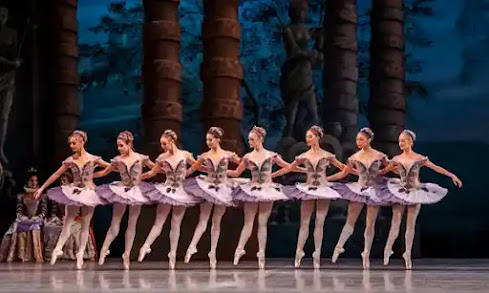Adaptation, Aesthetics, and Matthew Bourne’s Sleeping Beauty
Writing a spoiler alert for this post feels slightly stupid. Everyone has encountered some form of the ‘Sleeping Beauty’ story - likely in film, possibly in ballet, and probably through Tchaikovsky’s score (used initially for the ballet, but also in Walt Disney’s 1959 animated film). It’s worth being aware, nonetheless, that Sir Matthew Bourne’s adaptation of the classic story is pretty unique, so a spoiler alert has a legitimate use.
I was fortunate enough to attend a performance of Bourne’s Sleeping Beauty recently and whilst it was truly spectacular, it opened my eyes to some interesting dilemmas in adaptation. Really what struck me about the production was how much it strove to be unlike any rendition of ‘Sleeping Beauty’ which has come before it. It’s clear the extent to which this production aspires to be the fresh take. Bourne’s Sleeping Beauty is a highly self-conscious adaptation.
Take the promotional posters, for example. The production’s subtitle “A Gothic Romance” immediately evokes an entirely different aesthetic to Disney’s animation. It’s highly effective as an advertising ploy: there’s something attractive about Gothic romances which continues to puzzle and seduce audiences, and it moves away from the charming but childlike Disney romance into darker aesthetics and themes.
(It’s worth acknowledging that Matthew Bourne’s work is famous for its darker and more macabre versions of classical ballet pieces, and his Sleeping Beauty definitely fits this distinctive style.)
Overall, the focus here is on adaptation, and how this production prioritises the process and an aesthetics of adaptation. I think Bourne’s Sleeping Beauty lets adaptation run away with itself, with the result being a production which (particularly in the latter half) prioritises style over substance, and upsets the balance between movement, narrative, and aesthetic design.
The foremost way the production demonstrates this imbalance is in the differences between Acts I and IV. Whilst aesthetically the two acts are distinct from each other, they do maintain the stylistic thread which connects the whole ballet - an uncanny Gothic (or modern Gothic in Act IV) darkness, and Bourne’s distinctive contemporary ballet choreography. However, whilst Act I sustains a balance between aesthetic intrigue, stylised movement and an engaging narrative, this balance is not present in Act IV. This can be attributed to adaptation.
Act I is strongly connected to the classical narrative of Sleeping Beauty: a daughter is born to a king and queen, and at her christening, fairies bestow virtues as gifts upon the baby. Bourne’s production does not stray far from this expected scenario, and this in turn allows the audience to focus on aspects of movement and aesthetic. For those familiar with Marius Petipa’s ballet, the most significant changes Bourne makes in this moment of the story are to the choreography, and in his re-characterisation of the six fairies. That said, the narrative structure of Bourne’s choreography - and even some of the steps and highlights themselves - actually mimic and reiterate Petipa’s ballet.
These two images show an example of the striking similarities between Bourne's contemporary production and the classical productions it actively diverges from.
By contrast, Act IV’s deviation from the expected narrative leads to the audience working harder to formulate the story in their own understanding. Spoiler alert: some big storyline changes ahead. Bourne’s production extends the antagonistic role of Carabosse (or Maleficent, if you’re familiar with Disney) by introducing her son Caradoc, who aims to continue his mother’s malign mission against the royal family. In a sadistic act of vengeance, Caradoc’s manipulation of Aurora has gone so far by Act IV that the two are about to be married in a spectacular showcase of modern Gothic style.
In light of this, add the striking and fabulous aesthetics of Act IV’s modern Gothic costumes and set design to the mix and movement takes a backseat. Movement has remained consistent - that is, consistently stylised - throughout the production. Thus movement becomes the baseline which the audience falls back on, as they had relied upon their expectations of narrative in Act I.
Adaptation really does place style, in the sense of aesthetic design, over substance in this case. That’s not to say the choreography itself isn't brilliantly executed by the dancers, nor that it becomes boring, simply that the balance of movement, narrative, and aesthetics is upset in the third act.
What, then, can Matthew Bourne’s production tell us about adaptation?
As with all adapted works, Bourne’s Sleeping Beauty comes to its audiences with a set of preconceived expectations - conscious or not. Particularly for a story with such a rich history across mediums from literary to visual and audial art, Bourne’s production has some massive shoes to fill. So rather than try to fill them, the production embraces divergence from expectations in an aesthetic reimagination. For a dance production, an aesthetic approach makes total sense - the audience is coming to watch a performance.
In practice, the imbalances of narrative, movement and aesthetic created by this emphasis on aesthetic adaptation is the result here. This does not make Bourne’s Sleeping Beauty incoherent or ineffective as a narrative ballet. The production is stylish and dynamic, and its narrative is sound, but as a work of adaptation, it demonstrates how attempts to make something that is fundamentally new or different can result in largely surface-level, or aesthetic changes.


Comments
Post a Comment